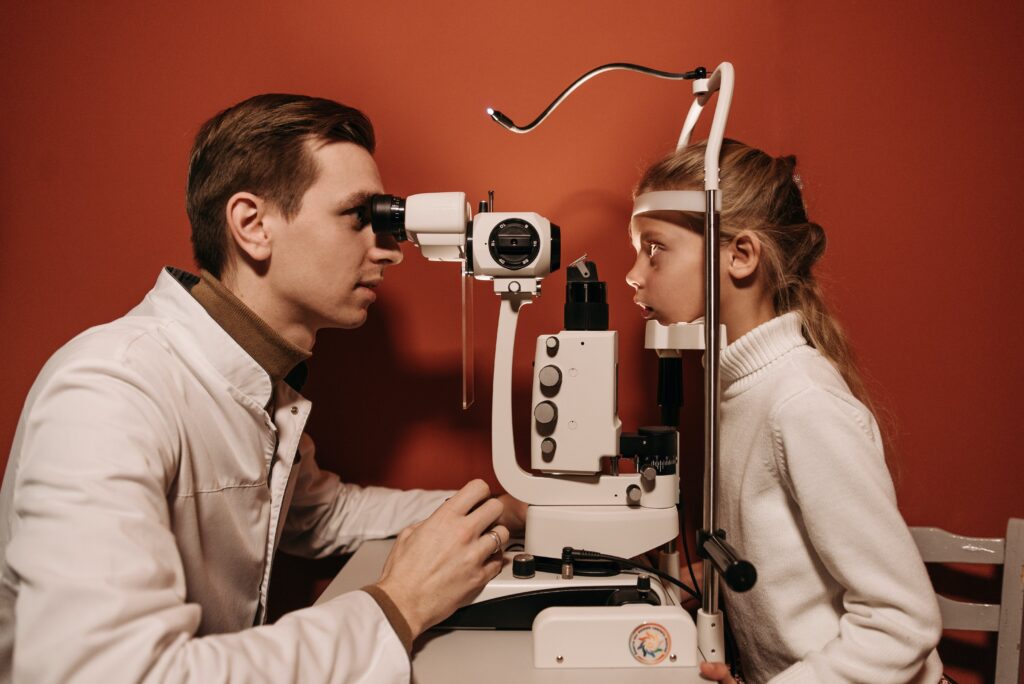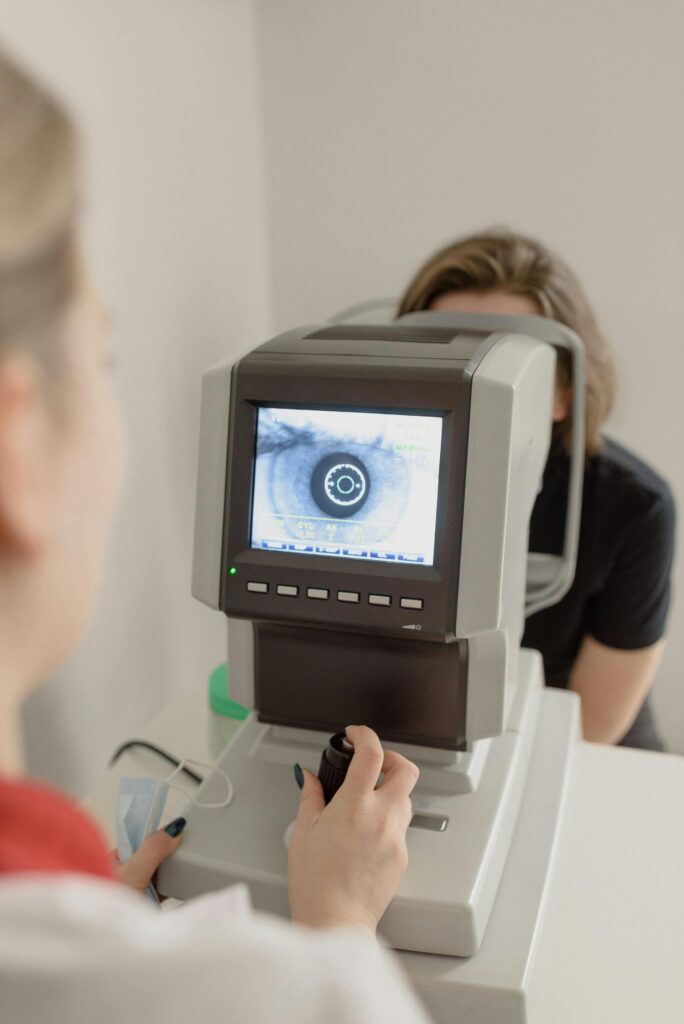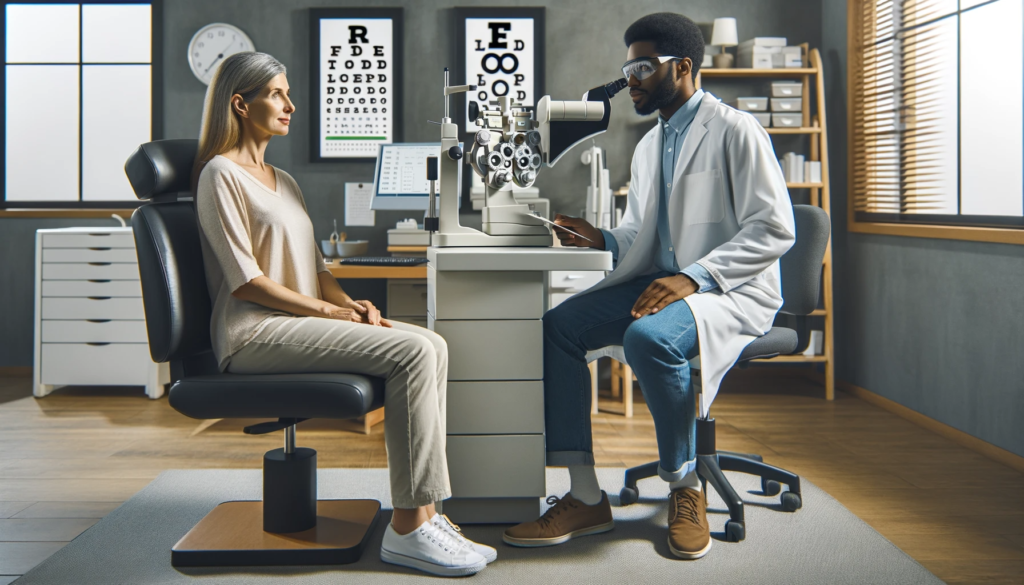Table of Contents
Welcome to our comprehensive guide on contact lens fitting, a crucial aspect of eye care that often goes overlooked. Whether you’re a seasoned lens wearer or considering contact lenses for the first time, understanding the intricacies of contact lens fitting is essential for optimal comfort, vision clarity, and eye health. This guide is designed to walk you through every aspect of the process, from choosing the right type of lenses and understanding the fitting procedure to maintaining your lenses and staying abreast of the latest advancements in lens technology. With expert insights and practical tips, you’ll be well-equipped to navigate the world of contact lenses with confidence and ease. Let’s dive into the details of ensuring a perfect fit for your contact lenses!
What is Contact Lens Fitting?
Contact lens fitting is a critical process in ensuring that your contact lenses provide optimal vision correction, comfort, and eye health. Unlike selecting standard eyewear, contact lens fitting involves a thorough evaluation by an eye care professional to determine the most suitable lens for your unique eye shape and vision needs.

At its core, contact lens fitting is about finding the right match between the lens and the eye. This process begins with a comprehensive eye examination. Your eye care professional will assess your vision and check for any eye health issues that could affect how you wear contact lenses. The focus is not just on correcting your vision, but also on ensuring the health and safety of your eyes.
Once the initial examination is complete, the next step is the actual fitting. This involves measuring the surface of your eyes, including the curvature of the cornea (the clear front surface of the eye) and the size of your pupil and iris. These measurements are crucial because they help the professional choose lenses that fit the contours of your eyes perfectly. A well-fitted lens sits comfortably on your eye, moves appropriately with each blink, and provides the necessary correction for your vision.
The importance of a precise contact lens fitting cannot be overstated. Ill-fitting lenses can cause discomfort, blurred vision, and even damage the eye. Symptoms of poorly fitted lenses include redness, dryness, and a feeling of something being in your eye.
After the initial fitting, it’s common to have a follow-up appointment. This is to ensure that the lenses are fitting well and that your eyes are adjusting properly. It’s also an opportunity to discuss any concerns or discomfort you may have experienced.

Why is Accurate Contact Lens Fitting Important?
Accurate contact lens fitting is fundamental to achieving the best visual acuity and maintaining the overall health of your eyes. When contact lenses are correctly fitted, they sit comfortably on your eyes, allow for proper movement and oxygen transmission, and minimize the risk of eye health complications.
First and foremost, accurate contact lens fitting ensures that the lenses correct your vision effectively. Whether you are nearsighted, farsighted, or have astigmatism, well-fitted lenses provide the precise correction needed for clear and sharp vision. This is particularly important for individuals with complex prescriptions, where precision in lens curvature and strength is key.
Moreover, comfort is a critical factor. Lenses that fit well are more comfortable to wear throughout the day. Poorly fitted lenses can cause discomfort, dryness, or the sensation of having a foreign body in the eye. These issues can discourage the consistent use of contact lenses and may lead to frequent eye rubbing, which further aggravates the eye.
The health of your eyes is also at stake with contact lens fitting. Ill-fitted lenses can restrict oxygen flow to the cornea, leading to conditions such as corneal neovascularization, where new blood vessels grow into the cornea in response to lack of oxygen. Additionally, lenses that are too tight can cause corneal abrasions or infections, while lenses that are too loose may not provide adequate protection against environmental factors.
Finally, an accurate contact lens fitting is essential for long-term eye health. Regular check-ups ensure that your lenses continue to fit well as your eyes and vision needs change over time. This proactive approach helps identify and address any potential issues before they become serious problems.

Types of Contact Lenses and Their Fitting Requirements
Understanding the different types of contact lenses and their specific fitting requirements is crucial for optimal comfort and vision. The world of contact lenses is diverse, with each type designed to cater to various vision needs and lifestyle preferences. Here, we delve into the common types of contact lenses and the unique aspects of their fitting process.
- Soft Contact Lenses: These are the most popular type due to their immediate comfort. Made from soft, flexible plastics that allow oxygen to pass through to the cornea, soft lenses are easier to adjust and are suitable for a variety of vision correction needs. The fitting for soft lenses involves ensuring that the lens sits comfortably on the eye, with enough movement to maintain eye health but not so much as to cause irritation or blurred vision.
- Rigid Gas Permeable (RGP) Lenses: RGP lenses offer sharper vision, especially for those with astigmatism. They are more durable and resistant to deposit buildup but can take some time to get used to. Fitting RGP lenses requires precise measurements of the cornea’s shape and size, as these lenses are less flexible and need to be specifically tailored to the individual’s eye.
- Extended Wear Lenses: These can be worn for prolonged periods, including overnight. Their fitting is similar to soft lenses but with additional consideration for oxygen permeability and eye health, given the extended wearing time.
- Disposable Lenses: These lenses are meant for short-term use, ranging from daily to monthly disposables. The fitting process is crucial to prevent eye infections, as the risk increases with the frequency of lens replacement.
- Specialized Contact Lenses: This category includes lenses for specific conditions like keratoconus or post-surgical needs. These lenses often require highly specialized fittings, given the unique shapes and conditions of the eyes they are designed for.
The Contact Lens Fitting Process
The contact lens fitting process is a series of steps undertaken by an eye care professional to ensure that your contact lenses are the perfect match for your eyes and vision needs. This process is crucial for comfort, optimal vision, and eye health. Here’s a breakdown of what it typically involves:
- Initial Eye Examination: Before any fitting, a comprehensive eye exam is conducted. This exam checks your overall eye health and determines your prescription. It’s important to detect any conditions that might affect contact lens wear, such as dry eyes or corneal irregularities.
- Corneal Measurement: The shape and size of your cornea are measured using instruments like a keratometer or a corneal topographer. These measurements are crucial because they help in selecting the lens curvature that fits your eye’s shape the best.
- Tear Film Evaluation: Your eye’s tear film is assessed to ensure that you have adequate tear production for comfortable lens wear. This is particularly important for people who suffer from dry eyes.
- Lens Selection and Trial: Based on the measurements and evaluation, the eye care professional selects a trial lens. You’ll try these lenses on, and the fit will be evaluated using a biomicroscope. This step assesses how well the lens sits on your eye, its movement, and overall alignment.
- Vision and Comfort Assessment: Once the lenses are in, your vision and comfort are evaluated. You’ll be asked about how the lenses feel, and your vision will be tested to ensure the lenses provide the necessary correction.
- Instruction on Lens Care and Handling: Before leaving, you’ll receive instructions on how to care for your lenses, how to put them in and take them out, and how to store them properly.
- Follow-up Visits: After the initial fitting, follow-up appointments are crucial. These visits assess how your eyes are adapting to the lenses and make any necessary adjustments.
Common Challenges in Contact Lens Fitting
Contact lens fitting can sometimes present challenges that require careful consideration and expert handling. Understanding these challenges is crucial for both wearers and eye care professionals to ensure a comfortable and effective contact lens experience. Here are some common challenges encountered during the contact lens fitting process:
- Irregular Corneal Shape: Conditions like keratoconus or significant astigmatism can make fitting contact lenses challenging. These irregularities require specialized lenses, such as toric or scleral lenses, and demand precise fitting to ensure comfort and optimal vision.
- Dry Eyes: Individuals with dry eyes may find it difficult to wear contact lenses comfortably. The lack of sufficient tear film can cause irritation and blurred vision. Special lenses designed for dry eyes, along with proper eye drops, can help mitigate this issue.
- Presbyopia: As people age, they often develop presbyopia, which affects their ability to focus on close objects. Fitting contact lenses for presbyopia can be challenging as it requires balancing near and distant vision. Multifocal lenses or monovision fitting are common solutions.
- Lens Stability and Rotation: For those with astigmatism, ensuring that toric lenses remain stable and do not rotate on the eye is crucial for clear vision. The fitting process for these lenses involves finding the right design that maintains its position during blinks and eye movements.
- Giant Papillary Conjunctivitis (GPC): This allergic reaction caused by lens wear can lead to discomfort and lens intolerance. Managing GPC involves finding the right type of lens material, proper lens care, and sometimes using medicated eye drops.
- Post-Surgical Eyes: Eyes that have undergone surgeries like LASIK require special attention during contact lens fitting. The changed shape of the cornea post-surgery can make fitting more complex.
Latest Advances in Contact Lens Technology and Fitting
The field of contact lens technology and fitting is constantly evolving, with new advancements designed to enhance comfort, vision, and overall eye health. Staying informed about these developments is crucial for both contact lens users and eye care professionals. Here, we explore some of the latest innovations in this field:
- Smart Contact Lenses: These cutting-edge lenses are equipped with microelectronics to monitor ocular health conditions or even assist in diabetes management by measuring glucose levels in tears. This technology represents a significant leap in personalized eye care.
- Improved Materials for Comfort: Recent developments in lens materials focus on increasing oxygen permeability and retaining more moisture. This results in lenses that are more comfortable to wear for longer periods, particularly beneficial for those with dry eyes.
- Customized Lens Design: Advances in imaging and manufacturing technologies allow for more personalized lens designs. This includes lenses tailored to the unique topography of an individual’s eye, offering a precise fit and improved vision correction.
- UV-Blocking Lenses: Some of the latest lenses come with built-in UV blockers to protect the eyes from harmful ultraviolet rays, an important feature considering the increasing concern about UV exposure.
- Bionic Lenses: Researchers are developing bionic contact lenses that could potentially provide vision correction that surpasses 20/20 vision, along with displaying information or augmenting reality directly within the user’s visual field.
- 3D Printed Lenses: The advent of 3D printing technology in lens manufacturing is opening doors to highly customized lenses made quicker and more efficiently than traditional methods.
- Scleral Lenses Update: Scleral lenses, large-diameter lenses that vault over the entire corneal surface, have seen improvements in design, making them more comfortable and easier to fit, especially for those with irregular corneas or severe dry eyes.
Choosing the Right Eye Care Professional for Contact Lens Fitting
Selecting the right eye care professional is a crucial step in the contact lens fitting process. The expertise and experience of the professional play a significant role in ensuring that your lenses are correctly fitted and your vision needs are adequately met. Here are key factors to consider when choosing an eye care professional for contact lens fitting:
- Qualifications and Experience: Look for an eye care professional specifically trained and experienced in contact lens fitting. This could be an optometrist or an ophthalmologist specialising in contact lenses. Their qualifications and years of experience can often be found on their practice website or through a simple inquiry.
- Reputation and Reviews: Check reviews and testimonials from other patients. This can give you insight into the practitioner’s reputation, the quality of care they provide, and their proficiency in handling various vision and lens fitting issues.
- Range of Services: Ensure that the professional offers a comprehensive range of services, including eye exams, contact lens fittings, follow-up care, and emergency services. A professional who provides a holistic range of eye care services is preferable.
- Technology and Equipment: A good eye care professional will use advanced technology and equipment for eye examinations and contact lens fittings. This ensures more accurate measurements and a better fit.
- Communication and Comfort: Choose a professional with whom you feel comfortable discussing your vision needs and concerns. Good communication is key to understanding and meeting your specific needs.
- Insurance and Cost Considerations: Consider whether the professional accepts your health insurance and understands the costs involved in the fitting process and follow-up care.
- Location and Accessibility: Convenience in terms of location and appointment availability can be important, especially if multiple visits are required.
Conclusion
In conclusion, understanding the nuances of contact lens fitting is vital for anyone considering or currently using contact lenses. From the initial selection of the right type of lens to the fitting process, and onto the ongoing maintenance and care, each step plays a critical role in ensuring a comfortable and healthy contact lens experience.
The advances in contact lens technology have made it possible to address a wide range of vision needs and preferences, making contact lenses a preferred choice for many. However, the importance of working with a qualified eye care professional cannot be overstated. Their expertise in contact lens fitting and eye health is indispensable in navigating the challenges that may arise and in making the most of the latest advancements in lens technology.
Remember, your eyes are as unique as your fingerprints, and so are your vision correction needs. Whether you are a first-time contact lens wearer or someone looking to switch to a different type of lens, always prioritize proper fitting and follow the recommended care routine. Regular check-ups are essential to ensure that your contact lenses continue to provide optimal vision correction and comfort.
In the world of vision correction, contact lenses offer a blend of convenience, efficiency, and effectiveness. By staying informed and proactive about your eye health, you can enjoy the many benefits of contact lenses while keeping your eyes healthy and happy.
Contact lens fitting is more than just a process; it’s a gateway to a clearer, more comfortable world of vision. Trust in the right professionals, embrace technological advancements and adhere to the care guidelines to make the most of your contact lens journey.
FAQs
- What is contact lens fitting? Contact lens fitting is the process an eye care professional uses to find the right contact lenses for your eyes. It involves measuring your eyes, evaluating your vision needs, and ensuring that the lenses chosen provide the best combination of vision correction, comfort, and eye health.
- How often should I get a contact lens fitting? You should have a contact lens fitting every time your prescription changes, typically every 1-2 years. It’s also recommended to have a fitting if you experience changes in vision or discomfort with your current lenses.
- Can I sleep in my contact lenses? Most contact lenses are not designed for overnight wear. Sleeping in lenses not meant for extended wear can increase the risk of eye infections and complications. Always follow the specific guidelines provided by your eye care professional.
- How do I know if my contact lenses are fitted properly? Properly fitted contact lenses should be comfortable, with no irritation or excessive movement. Your vision should be clear, and there shouldn’t be any redness or dryness. If you experience any discomfort, consult your eye care professional.
- Are there contact lenses for dry eyes? Yes, there are specially designed lenses for people with dry eyes. These lenses are made from materials that retain more moisture or allow more oxygen to pass through, providing greater comfort.
- Is contact lens fitting necessary for coloured lenses? Yes, even if you want coloured lenses for cosmetic purposes and not for vision correction, a proper fitting is essential. Ill-fitting lenses can cause discomfort and eye health issues.
- How long does a contact lens fitting take? A typical contact lens fitting can take anywhere from 30 minutes to an hour, depending on the complexity of your vision needs and the type of lenses being fitted.
- Can I wear contact lenses if I have astigmatism? Yes, there are toric lenses designed specifically for people with astigmatism. These lenses require a precise fitting to ensure proper orientation and vision correction.
Sources:
https://www.pearlevision.ca/pv-ca/contact-lenses-contact-lens-fitting


